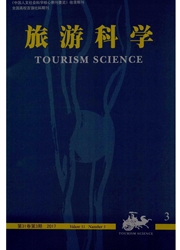

 中文摘要:
中文摘要:
摘要:本文采用文本挖掘方法分析了新浪博客中关于朱家角的2633篇博文,根据词频统计结果,将游客对朱家角的旅游感知形象划分为地理位置形象、旅游地类型形象和地方性形象3种,其中旅游地类型形象涵盖词条数最多、频次最高,这表明朱家角作为江南古镇的类型形象强于朱家角的地理位置形象和地方性形象。通过共现分析发现,江南古镇的名称常常多个同时出现在博文中,这也表明朱家角与其他江南古镇的竞争表现在类型形象上,而非表现为与某特定古镇的竞争。结合长尾理论,本文发现,游客对朱家角旅游形象的感知呈现出“长尾”特征,同时在形象曲线的尾部出现了“非利基”形象,开发小众旅游产品时需要对出现在长尾中的形象进行仔细甄别。本文提出,在江南古镇整体氛围塑造的基础上,融入老上海元素和开发创意文化旅游产品,可以作为朱家角进行旅游产品差异化开发的一种方式。
 英文摘要:
英文摘要:
With the application of text mining, this study captured 2633 blogs related with Zhujiajiao, an ancient town in Shanghai, from the most popular hlogging platform in China- Sinablog, and recognized tourists' perceived image frequency of every image items, tourists' through automatic segmentation of blog texts. Based on perceived image of Zhujiajiao was divided into three categories namely locational image, type image and localized image. It indicated that type image impressed the tourists most rather than locational image or localized image. Also, results of cooccurrence analysis justified the predominance of typological image and suggested that Zhujiajiao was not competing with some certain ancient towns but the common image with type representativeness. Moreover, a long tail characteristic of tourists' perceived image was discovered, while among the long tail there were numerous non-niche images not useful to niche market strategies of the destination. According to these findings, it was proposed that in order to gain differentiated competitive advantages, Zhujiajiao should nourish its niche market and integrate Old Shanghai elements and creative cultural services into its attraction list.
 同期刊论文项目
同期刊论文项目
 同项目期刊论文
同项目期刊论文
 期刊信息
期刊信息
